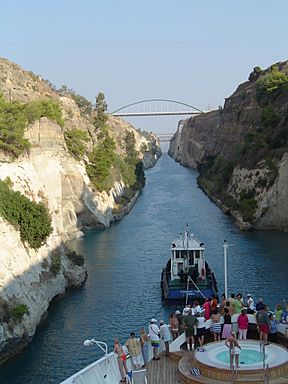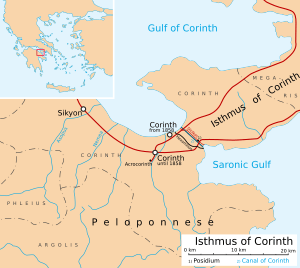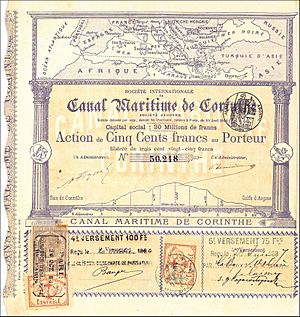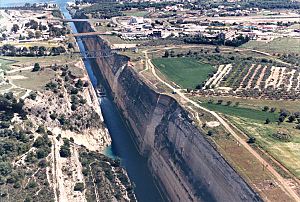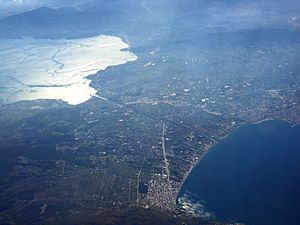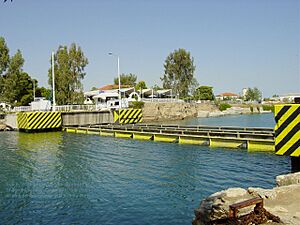Corinth Canal facts for kids
The Corinth Canal (Greek: Διώρυγα της Κορίνθου, romanized: Dhioryga tis Korinthou) is a famous waterway in Greece. It connects two important seas: the Gulf of Corinth (part of the Ionian Sea) and the Saronic Gulf (part of the Aegean Sea). This canal cuts through a narrow strip of land called the Isthmus of Corinth. It separates the Peloponnese region from the rest of the Greek mainland, making the Peloponnese almost like an island.
The canal was dug right at sea level, so it doesn't need any special water locks to raise or lower ships. It is about 6.4 kilometres (4 mi) long. At its narrowest point, it's only 21.4 metres (70 ft) wide. This means many large, modern ships cannot fit through it. Today, the Corinth Canal is not as important for trade as it once was. Instead, it's mostly a popular spot for tourists.
People first thought about building this canal thousands of years ago. A serious attempt was made in the 1st century AD, but it failed. Construction finally began in 1881. The project faced many challenges, including money problems and difficult ground conditions. These issues even caused the first companies to go bankrupt. The canal was finished in 1893. However, because it was so narrow and had problems with landslides from its steep walls, it never became as busy as people hoped.
Contents
History of the Corinth Canal
People have dreamed of digging a canal through the Isthmus of Corinth for a very long time. It would save ships a long journey around the Peloponnese.
Ancient Attempts to Build the Canal
The first person to suggest digging a canal was a ruler named Periander in the 7th century BC. He was a "tyrant," which meant he was a powerful leader of a city. However, Periander decided not to build the canal. Instead, he created a simpler, cheaper road called the Diolkos. This stone road allowed ships to be pulled overland from one side of the isthmus to the other. Some parts of the Diolkos can still be seen near the modern canal today.
Later, a general named Demetrius Poliorcetes (who lived from 336 to 283 BC) also planned a canal. He wanted to make it easier to move his army and supplies. But his surveyors made a mistake when measuring the sea levels. They worried that digging a canal would cause huge floods, so the plan was stopped.
Ancient writers like Plutarch and Suetonius wrote that several Roman rulers thought about building the canal.
- The Roman leader Julius Caesar considered it, but he was assassinated before he could start.
- Emperor Caligula (who ruled around 40 AD) asked experts from Egypt to study the idea. They wrongly thought the Corinthian Gulf was higher than the Saronic Gulf. They feared that if a canal was dug, the island of Aegina would be flooded. Caligula was also assassinated before he could begin the project.

Emperor Nero was the first to actually start digging the canal in 67 AD. He even used a pickaxe himself to begin the work! His workers included 6,000 Jewish prisoners of war. They started digging trenches from both sides of the isthmus. Nero's project was abandoned when he died shortly after it began. His workers had dug about 700 metres (2,300 ft) (or about a tenth of the total distance). A carving of Hercules left by Nero's workers can still be seen in the canal walls.
Other people considered the canal idea over the centuries, but no one started a new project until much later.
Building the Modern Canal
The idea for a canal came back after Greece became independent from the Ottoman Empire in 1830. The Greek leader Ioannis Kapodistrias asked a French engineer to check if it was possible. But the cost was too high for the new country.
The successful opening of the Suez Canal in 1869 gave new hope for the Corinth Canal. In 1870, the Greek government passed a law to allow its construction. French companies tried to build it, but they ran into financial trouble.
A new company, the Société Internationale du Canal Maritime de Corinthe, took over in 1881. Construction officially began on April 23, 1882, with King George I of Greece present. The company quickly ran out of money. Its head, István Türr, went bankrupt, and so did the company.
Work restarted in 1890 when a Greek company took over. The canal was finally finished on July 25, 1893, after eleven years of hard work.
After the Canal Was Built

Even after it was finished, the canal faced many problems.
- Navigation is hard: The canal is very narrow, making it difficult for ships to steer. Strong winds blow through the channel, and different tides in the two gulfs create strong currents. Because of this, many ship captains didn't want to use the canal.
- Less traffic than expected: People thought millions of tons of goods would pass through each year. But by 1906, only half a million tons were using it. Traffic slowly grew, but World War I caused a big drop.
- Landslides: The canal was cut through limestone rock in an active seismic zone (where earthquakes happen). The high walls were often unstable. Landslides caused the canal to close many times for repairs. For example, in 1923, a huge amount of rock fell into the canal, taking two years to clear. Between 1893 and 1940, the canal was closed for a total of four years for maintenance.
The canal was also badly damaged during World War II. In 1941, during the Battle of Greece, German forces tried to capture the main bridge over the canal. The British defenders destroyed the bridge to stop them. Later, in 1944, as German forces left Greece, they blew up parts of the canal to block it. They caused landslides, destroyed bridges, and dumped wreckage into the water.
The United States Army Corps of Engineers helped clear the canal after the war. It was fully reopened for all ships by September 1948.
Modern Use of the Canal
Today, the Corinth Canal is still open. However, because it's so narrow, it's mostly used by smaller boats, especially tourist ships. It's a popular attraction for people who want to see this amazing engineering feat. About 11,000 ships travel through the canal each year.
A special event happened on October 9, 2019. The cruise ship MS Braemar became the widest and longest ship to ever go through the canal. It was 22.5 metres (74 ft) wide and 195 metres (640 ft) long, carrying over 900 passengers!
Layout of the Corinth Canal
The Corinth Canal is a single channel that is 8 metres (26 ft) deep. It was dug at sea level, so it doesn't need any locks. The canal is 6,343 metres (20,810 ft) long. It is 24.6 metres (81 ft) wide at sea level and 21.3 metres (70 ft) wide at the bottom.
The rock walls of the canal are very high, rising 90 metres (300 ft) above the water. They are almost vertical, at an 80-degree angle. Several bridges cross the canal high above the water, including a railway line, a road, and a motorway. In 1988, special submersible bridges were added at each end of the canal. These bridges can sink below the water to let ships pass.
Even though the canal saves ships a 700-kilometre (430 mi) journey around the Peloponnese, it's too narrow for most modern cargo ships. It can only fit ships up to 17.6 metres (58 ft) wide and with a draft (how deep the ship sits in the water) of up to 7.3 metres (24 ft).
Ships can only pass through the canal one at a time. Larger ships sometimes need to be pulled by tugs.
Images for kids
See also
 In Spanish: Canal de Corinto para niños
In Spanish: Canal de Corinto para niños


